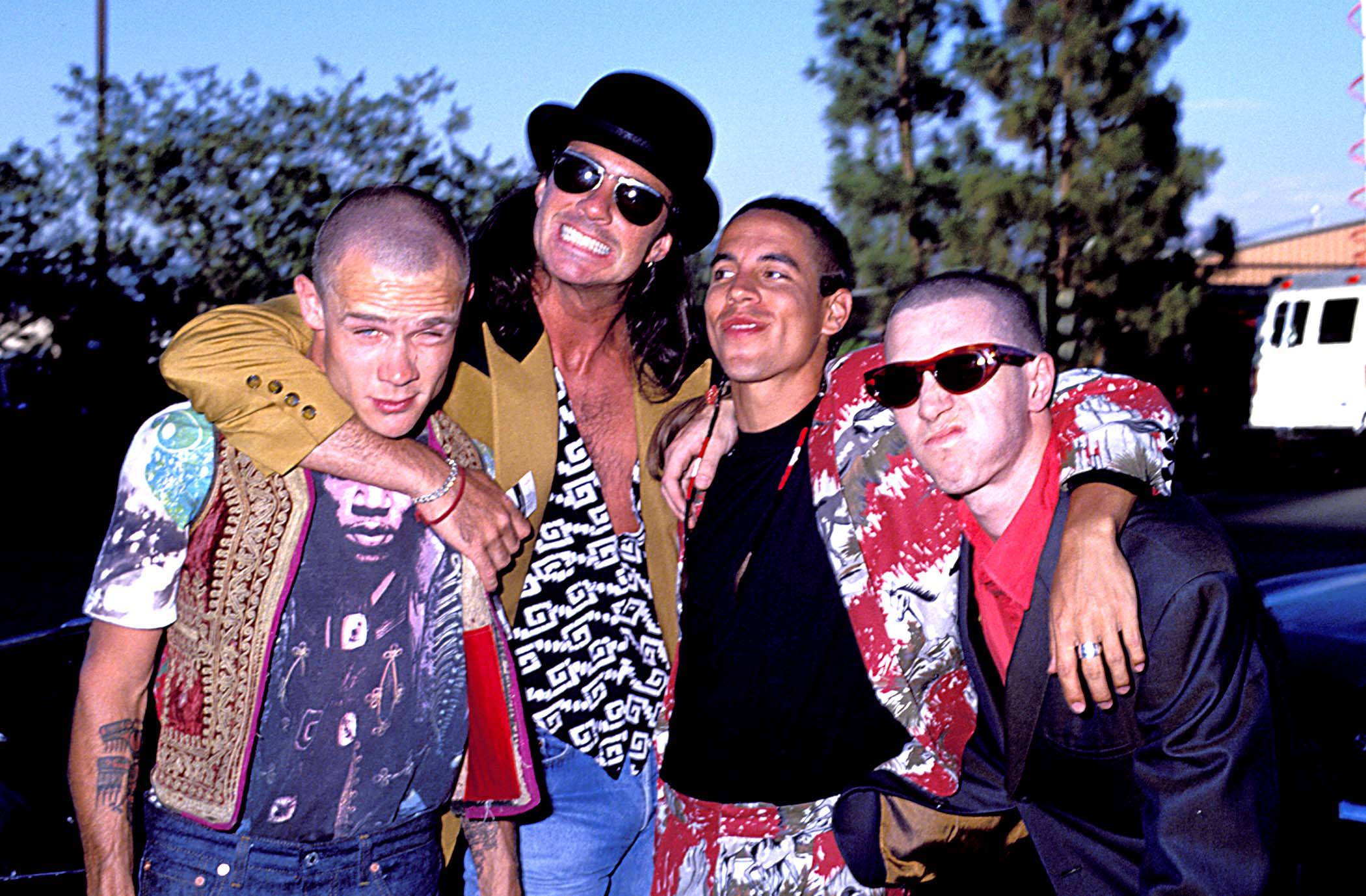
Red Hot Chili Peppers have been one of the most consistently popular bands in the world for most of their 39 years together, but it hasn’t always been an easy ride. Frontman Anthony Kiedis and bassist Flea have been the only constants throughout the band’s history. Over the years, they’ve recorded albums with five different guitarists and three different drummers, whether lineup changes were prompted by the tragic death of co-founder Hillel Slovak or his successor John Frusciante passing the baton to Dave Navarro or Josh Klinghoffer.
On April 1, Red Hot Chili Peppers are releasing their 12th studio album Unlimited Love, which reunites the band with Frusciante and the producer behind their most beloved albums, Rick Rubin. So let’s take a look at where the new album ranks among the L.A. band’s era-defining smashes like Blood Sugar Sex Magik and Californication.
12. The Red Hot Chili Peppers (1984)
[embedded content][embedded content]
The Red Hot Chili Peppers only had half of their founding lineup on board to record their debut album. Hillel Slovak and Jack Irons were otherwise engaged with their other band, What Is This?, which signed a record deal two weeks before RHCP did. So Anthony Kiedis and Flea recruited guitarist Jack Sherman and drummer Cliff Martinez to fill out the lineup and hired Andy Gill of British post-punk legends Gang of Four to produce. Unfortunately, Gill’s production is surprisingly slick and toothless, lacking the edge of Gang of Four’s best self-produced albums. And while “Police Helicopter” and “True Men Don’t Kill Coyotes” are early stand-outs in the band’s catalog, there’s a palpable sense that their debut could’ve been far better with the right people in the studio. “The band is outrageous enough, though probably not the way it thinks it is,” wrote an unimpressed Robert Christgau.
11. The Getaway (2016)
[embedded content][embedded content]
The Getaway was the second Red Hot Chili Peppers album with guitarist Josh Klinghoffer. It is the only album of the past 30 years produced by anyone besides Rick Rubin. They enlisted Danger Mouse, who’s produced blockbuster hits by Gnarls Barkley, Gorillaz, and Beck, but is generally more comfortable manning a drum machine and sampler than recording a live band. Chad Smith’s kit had never sounded flat and thin like it does on The Getaway, which detracts from the otherwise lush, experimental textures on the album. While “Goodbye Angels” and “Go Robot” feature some tasty slap bass, Flea seems inspired by his time away making a solo EP and joining Thom Yorke’s Atoms For Peace, playing more subtle melodic basslines throughout The Getaway.
10. One Hot Minute (1995)
[embedded content][embedded content]
When John Frusciante left Red Hot Chili Peppers for the first time in 1992, they were in the middle of a long stretch of worldwide touring in support of Blood Sugar Sex Magik. After a couple of temporary guitarists helped them finish the tour, the Chili Peppers drafted a big name to record the highly anticipated follow-up. On paper, Dave Navarro was a perfect match. Jane’s Addiction and RHCP came up together on the same ‘80s L.A. scene with their own eclectic approaches to hard rock. But the new Chili Peppers unveiled on One Hot Minute were a little heavier and a little less funky, and the creative chemistry wasn’t quite what everyone expected. “Aeroplane” remains the band’s best bubblegum pop confection, and there are some interesting experiments like Flea’s lead vocal turns on “Pea” and the end of “Deep Kick.” But when Navarro left RHCP in 1998, One Hot Minute’s fate was sealed as an overpromoted, underwhelming chapter in the band’s history. “One Hot Minute finds them venturing further down pop’s path, sculpting their hyperactive musicianship into denser, more pointed soundscapes,” Chris Norris wrote in the SPIN review.
9. Freaky Styley (1985)
[embedded content][embedded content]
The Red Hot Chili Peppers’ debut album had barely touched the charts, but things were trending up on Freaky Style. Hillel Slovak rejoined the band, and one of the band’s heroes, George Clinton, signed on to produce. Freaky Styley is an intriguing look at the road not taken, with the Chili Peppers as close as they’d ever get to being a full-on funk band. They featured a horn section with Maceo Parker and Fred Wesley that bolstered covers of The Meters and Sly & The Family Stone. There are also glimpses of Slovak’s deeply original approach to guitar, and songs like “Catholic School Girls Rule” that maintain the band’s punkier side.
8. By The Way (2002)
[embedded content][embedded content]
Throughout By The Way, John Frusciante toys with doo-wop harmonies and pulls psychedelic textures from Mellotron, melodica, and modular synths. In a comfortable groove after Californication, “The Zephyr Song” and “Midnight” are mellow delights from the prettiest Chili Peppers album. But there’s still a hard rock edge to its biggest hits, “Can’t Stop” and the dynamic title track. “They swim around in the same inviting Southern California waters that inspired the Beach Boys, and discover that the incandescent hook can say as much as, if not more than, the testosterone-driven backbeat,” wrote Tom Moon in the Rolling Stone review.
7. Unlimited Love (2022)
[embedded content][embedded content]
Unlimited Love is the first RHCP album with John Frusciante in over 15 years, and his unmistakable signatures are all over it, with inspired discordant shredding on “The Great Apes” and “Watchu Thinkin’” and even shared lead vocals with Anthony Kiedis on “The Heavy Wing.” But there are subtle surprises as well, from the piano ballad “Not the One” to the way “Bastards of Love” veers between synth-pop verses and a twangy country-fried chorus and a funk-rock bridge. Unfortunately, a few of the 17 songs run light on inspiration, and on “One Way Traffic” it sounds like Anthony Kiedis is just free-associating about some of the duller aspects of getting older (“Friends got married, had them dogs/ Now they read those catalogs”). Aptly titled, Unlimited Love is familiar and inviting, but not quite a comeback to the band’s creative peak.
6. I’m With You (2011)
[embedded content][embedded content]
The second time John Frusciante stepped away from Red Hot Chili Peppers in 2009, they looked to their inner circle to take his place: Josh Klinghoffer, a collaborator and protégé of Frusciante who’d been a touring member of the band since 2006. On the first day of rehearsals for I’m With You, Anthony Kiedis learned of the death of Brendan Mullen, a longtime friend of the band who’d helped the band early on as an L.A. club promoter. The band soon began jamming and came up with “Brendan’s Death Song,” a standout late-period track that builds from an acoustic intro to a celebratory funeral march. The funky lead single “The Adventures of Rain Dance Maggie” became the band’s record-setting 12th No. 1 song on Billboard’s Alternative chart (a record they still hold with 14 chart-toppers).
5. Stadium Arcadium (2006)
[embedded content][embedded content]
When we talk about “double albums,” we’re usually talking about up to 80 minutes spread over two vinyl LPs. But relatively few bands have swung for the fences with a double CD of over two hours of music. And at 122 minutes, Stadium Arcadium is one of the longest blockbuster albums released by a major rock band, edging out Smashing Pumpkins’ Mellon Collie and the Infinite Sadness by less than a minute. As double albums go, it’s not revelatory or experimental. But Stadium Arcardium’s sprawl allows the Chili Peppers to stretch their legs and do a bit of everything they do well, from the rustic southwestern twang of “Slow Cheetah” and “If” to the band’s best straight-up funk tracks since the early ‘90s, “Hump De Bump” and “Warlocks.”
4. Mother’s Milk (1989)
[embedded content][embedded content]
The bittersweet triumph of reaching new heights of commercial success with the first album after the death of a key member is something that only a few bands like AC/DC, Metallica, the Pretenders, and the B-52’s have experienced. Following Hillel Slovak’s fatal overdose in 1988, a grief-stricken Jack Irons left the band. Anthony Kiedis and Flea slowly picked up the pieces, testing out new bandmates on tour. Eventually, they found two guys who had a long future ahead of them as Chili Peppers: the brilliant, mercurial 19-year-old guitarist John Frusciante, and the hard-hitting, unfailingly steady drummer Chad Smith. Mother’s Milk became RHCP’s radio breakthrough and the band’s first album to go Gold. The band was increasingly become the new face of L.A. rock, saluting their hometown influences Fishbone, X, and Thelonious Monster in a collage of samples on the opening track “Good Time Boys.” The single “Knock Me Down” showed the melodic power of the new lineup while poignantly reflecting on the damage that drugs had done to the band. And the instrumental “Pretty Little Ditty” became a hit of sorts a decade later when sampled on Crazytown’s “Butterfly.”
3. The Uplift Mofo Party Plan (1987)
[embedded content][embedded content]
Although several songs co-written by Jack Irons appeared on the band’s first two albums, The Uplift Mofo Party Plan is the only RHCP album with him on drums. As the only studio document of the band’s founding lineup, it’s absolutely essential Chili Peppers. It features monster grooves like the evergreen live staple “Me and My Friends.” Hillel Slovak’s creativity and versatility is on full display, including his most inspired guitar solo on “Backwoods,” vocoder on “Funky Crime,” and sitar on “Behind the Sun.” The latter belatedly reached the top 10 of Billboard’s Modern Rock chart when it was released as a single from the band’s What Hits!? compilation in 1992.
2. Californication (1999)
[embedded content][embedded content]
The fusion of rock and hip-hop that Red Hot Chili Peppers had pioneered for over a decade was a multi-platinum cottage industry by the late ‘90s. While RHCP’s reunion with John Frusciante on Californication yielded a few funky, hip-hop tinged jams like “Around the World” and “Get on Top,” the album became a blockbuster largely because the band’s mastery of melodic midtempo songs like “Scar Tissue,” “Otherside,” and the title track. It’s Anthony Kiedis’s finest hour as a singer and lyricist (save for maybe his ode to a fling with Mel C. of the Spice Girls, “Emit Remmus”), and the best possible way the band could’ve ended the tumultuous decade that turned them into superstars.
1. Blood Sugar Sex Magik (1991)
[embedded content][embedded content]
In 1991, nobody lived at the intersection of hip-hop and rock’n’roll quite as squarely as Rick Rubin, the Def Jam co-founder who masterminded Run-DMC’s “Walk This Way” and the Beastie Boys’ Licensed To Ill before producing bands including Slayer and Danzig. But nobody could have predicted just how wildly successful Red Hot Chili Peppers would become under Rubin’s tutelage on Blood Sugar Sex Magik. The band and the producer moved into a (supposedly haunted) L.A. mansion converted into a recording studio, churning out iconic anthems like “Give It Away” and “Suck My Kiss.” And when Rubin found a vulnerable autobiographical poem in Kiedis’s notebook and encouraged the band to set it to music, the unlikely power ballad “Under the Bridge” was born, unlocking a different side of the band and helping turn them into a multi-platinum phenomenon. “There’s often an almost delicate quality to some of the playing, the band’s airiest funk yet, highlighted by John Frusciante’s often-understated guitar,” wrote Steve Hochman in the Los Angeles Times review.

Leave a comment